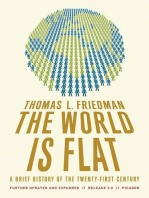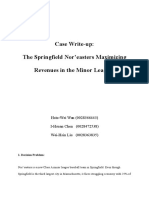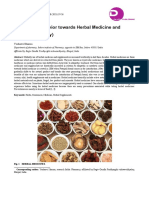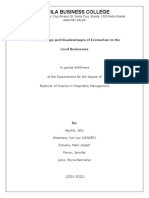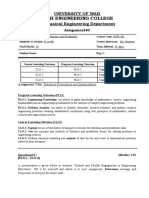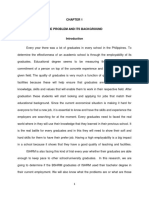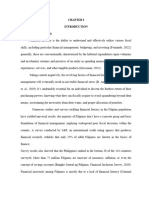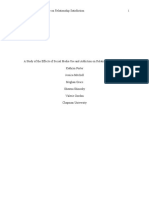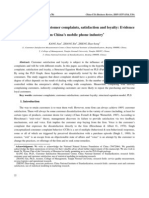Qualitative Interview Strategies
Qualitative Interview Strategies
Uploaded by
Klarence LimCopyright:
Available Formats
Qualitative Interview Strategies
Qualitative Interview Strategies
Uploaded by
Klarence LimCopyright
Available Formats
Share this document
Did you find this document useful?
Is this content inappropriate?
Copyright:
Available Formats
Qualitative Interview Strategies
Qualitative Interview Strategies
Uploaded by
Klarence LimCopyright:
Available Formats
Qualitative Interviews
I-TECHs Technical Implementation Guides are a series of practical and instructional papers designed
to support staff and partners in their efforts to create and maintain quality programs worldwide.
I - T E C H T E C H N I C A L I M P L E M E N T A T I O N G U I D E # 5
What Are Qualitative Interviews?
Qualitative interviews are considered the back-
bone of qualitative research and evaluation. Unlike
surveys, which consist of carefully worded, closed-
ended questions, qualitative interviews are one-on-
one, interactive conversations between an inter-
viewer and an informant. The objective of qualitative
interviews is to get detailed information, in the form
of narratives or stories,* of peoples experiences,
local histories, and shared knowledge to get verbal
pictures of systematic behaviors. Data derived from
qualitative interviews are rich, in-depth descriptions
that explain and give meaning to peoples lives. Un-
like surveys, the success of a qualitative interview
rests on the skill of the interviewer, rather than on
the quality of the questionnaire. For this reason,
training eld staff on how best to conduct in-depth
interviews prior to initiating a study, evaluation, or
assessment is critical.
Types of Qualitative Interviews
Though all qualitative interviews contain the same
basic elements of discussion, detail, and descrip-
tion, they vary with respect to how much control
the interviewer has over the informants answers.
The structure can range from loosewhere the in-
terviewer has minimal control over responsesto
rigidwhere the interviewer asks a specic set of
questions and the informant has little room to elabo-
rate. The choice of structure depends on the type of
investigation being conducted and the purpose of
the interview. Different types of questions are used
depending on the type of interview structure and
the interviewers level of control. What the different
types of interviews have in common, however, is
that they are all purposeful and systematicthat is,
the interviewer has an objective and a plan for col-
lecting the intended information.
Unstructured Interviews
As a general rule, unstructured interviews are use-
ful for exploratory investigations of new topics and
ideas, or when the topic under study is not well
known or understood. The idea is to allow informants
to express themselves freely, with minimal control
imposed by the interviewer, in order to gain the
most information possible. Unstructured interviews
involve an interviewer sitting down with another
person and having what appears to be an informal
discussion. In fact, however, the interviewer puts a
lot of thought into the interview before it starts. For
example, he or she must know what topics to cover
and the direction in which to steer the discussion. In
most cases, the interviewer will use a checklist to
guide the direction of the interview. During the inter-
view itself, the interviewer gently guides the ow of
information by probing the informant for more detail
while making sure the discussion doesnt veer too
far off topic. Because of its interactive nature, un-
structured interviewing often depends on the ability
and experience of the interviewer. For this reason,
selecting interviewers with demonstrated experi-
ence and skills in both interviewing and note taking
is highly advisable.
In a formative study or evaluation, unstructured inter-
views are often done at the beginning because a great
deal of information can be gathered in a short period
of time. This data can then be used to inform other
phases of the study, such as developing interview
guides and survey questions to be used later on.
*The term story means the same as chronicle or true account of a persons life experiences rather than a ctional tale.
QUALITATIVE INTERVIEWS: A TECHNICAL IMPLEMENTATION GUIDE PAGE 2
Type Format Responses Data Use Question
Example
Unstructured Checklist,
interview
guide
Less controlled;
exploratory
and exible;
informants are
encouraged to
tell their stories
Can be tape re-
corded or recorded
in eld notes
depending on the
need for exact
detail; transcripts
and notes can be
coded into a text-
based database
(e.g., NUD*IST,
Ethnograph); often
produces volumes
of data
Quality of data
depends inter-
viewers skill;
generates a large
amount of rich,
detailed data;
very effective for
uncovering new
information
Can you tell me
about your rst
boyfriend?
Semi-
structured
Written inter-
view script;
all questions
written down;
script includes
interviewer
instructions
Controlled; more
detailed; compa-
rable responses;
little room for ex-
ploration beyond
interview script
Same as above,
though usu-
ally produces nar-
rower range and
quantity of data
With adequate
training and prac-
tice, can be used
successfully with
less experienced
interviewers;
easier to compare
answers
Can you tell me
about the rst time
you and your
partner talked about
using condoms?
[Prompt: Who rst
suggested con-
doms? What did
you/he say? How
did you/he react?]
Structured Most common
format is open-
ended survey
questions;
short answers;
often include
interviewer
directions on
specic probes
and when to
use them
Highly controlled
and specic; lim-
ited detail; most
easily compa-
rable since each
person inter-
viewed has been
exposed to exact
same group of
questions
Usually recorded
on survey instru-
ment; can be
easily transformed
into numerical
data
Can verify infor-
mation from in-
depth interviews;
easily integrated
into surveys; ef-
fective with large
study populations;
generally easiest
type of interview-
ing to train up
staff to conduct
Over the last
month, in what
locations did you
buy drugs?
Semi-structured Interviews
In contrast to unstructured interviews, a semi-struc-
tured interview is more controlled by the interviewer.
Instead of a checklist, interviewers work from a script
of proscribed questions, called an interview guide,
which sometimes has prompts that allow for limited
exibility. The interview guide allows the interviewer
room to follow new leads while also demonstrating
that she or he is prepared and has the situation under
control. The interviewer will likely need to be able to
skillfully move between proscribed and unstructured
questions in order to clarify responses or ask for elab-
oration if a participant seems to provide contradictory
information. Thus, providing interview staff with train-
ing and practice beforehand is highly advisable.
Semi-structured interviews are very useful tools for
obtaining specic details about a topic that has al-
ready been explored in unstructured interviews, or
for comparing answers among a larger group of infor-
mants. This type of interview also works well in situa-
tions where the informant is accustomed to efcient
use of time, for example, doctors in a busy clinic.
QUALITATIVE INTERVIEWS: A TECHNICAL IMPLEMENTATION GUIDE PAGE 3
Structured Interviews
In this type of interview, carefully and fully worded
questions are developed before the interview is
conducted. Each informant gets asked the same
questions in the same way with the same probes.
Structured interviews facilitate cross-comparison of
answers across time and can compensate for variabil-
ity in research skills across different interviewers.
Structured interviews are best used when a lot of in-
formation about the topic is already known, perhaps
collected via previous open-ended interviews. The
weakness of the standardized approach inherent to
structured interviews is that it does not permit the
interviewer to pursue topics or issues that were not
anticipated when the interview instrument was writ-
ten. Structured interviews also reduce the extent to
which individual circumstances and differences can
be explored
1
.
Types of Informants
In general, there are two types of informants used in
qualitative interviews: key informants and specialized
informants
2
. The difference between them relates to
their knowledge level of the interview subject and
their relationship with the interviewer.
Key Informants
Key informants are people who have much knowl-
edge about their culture and are often well connected
within their communities. Generally speaking, they
are easy to talk to and willing to share information.
They may also have special insight about the big
picturelarger social, cultural, and/or political fac-
tors that might affect local conditions and behaviors.
In addition, these informants tend to be thoughtful
and articulate, and seem to understand what the
interviewer wants to know. Importantly, when they
are unable to provide the information the interview-
er is looking for, key informants often serve as local
gatekeepers who can introduce the interviewer to
other individuals who can be of help.
The term key informant does not mean the same
thing as educated person or authoritative ofcial.
In fact, the best key informants may not be persons
of authority at all, but rather unofcial experts who
know whats really going on. In long-term ethnogra-
phy studies where the interviewer and the key infor-
mant spend much time together, close relationships
are often formed between them. Alternatively, peo-
ple sometimes become key informants because of
their close relationship with the interviewer and their
ability to understand what information she or he is
seeking. Regardless of how the relationship devel-
ops, it is often the case that the interviewer and the
key informants choose each other over time, rather
than the interviewer choosing the informants.
Finding good gatekeepers is extremely important
for studies in which target populations are hidden,
vulnerable, and/or stigmatized. For example, an im-
portant key informant for a study on commercial sex
work might be a taxi driver, who knows the locations
where sex work is usually conducted and who may
already be known and trusted by many of the clients
and sex workers themselves. Because key informant
knowledge is specialized and particular to the indi-
vidual, interviews tend to be unstructured, with inter-
viewers using checklists to guide the discussion.
Other Informants
Other informants are selected for interviews be-
cause they represent in some way a larger group of
individuals the interviewer is trying to understand.
If possible, it is best for interviewers to nd infor-
mants who represent a diversity of knowledge and
perspectives on the study topic in order to reduce
bias. Using a broad group of informants also provides
access to a wide array of viewpoints. For longer or
larger studies, informants can be selected using ran-
dom and stratied sampling techniques; however,
care should be taken to ensure that the different rel-
evant categories of people (sex, age, ethnic group,
religion, etc.) are evenly represented.
Getting the Most out of an Interview
Building Rapport
The best way to guarantee a successful qualitative
interview is to put the informant at ease and gain
his or her trust. People are more willing to express
themselves if they feel comfortable and safe. Inter-
QUALITATIVE INTERVIEWS: A TECHNICAL IMPLEMENTATION GUIDE PAGE 4
views should start with an appropriate greeting and
an introduction of the interviewer, the project, and
the projects purpose. Informants should be told why
they have been selected for participation, and how
the information they provide will assist the project,
such as interviewers or researchers understanding
a problem in order to help improve services. Infor-
mants like to know that their stories will be of some
benet. They should also be told that the information
they provide will be kept condential, and the steps
taken to protect their privacy should be outlined.
If the subject matter is sensitive or personal, such
as sexual behavior or illegal activities, informants
should be told ahead of time and assured they do
not have to answer any questions that make them
feel uncomfortable. They should also be informed
whether they will be compensated for the interview
and, if so, what that compensation will be. These
few steps, which take less than 5 or 10 minutes,
can make the difference between eliciting a rich, de-
tailed, and insightful narrative and a skimpy, vague,
and uninformative exercise.
Interviewing Tips
1. Build rapport
n Be sure to introduce yourself and explain the
project
n Help the informant feel at ease
2. Sequence questions
n Start in the present and move towards the
past and future
n Move from impersonal to personal
n Facts rst, then opinions
n Save sensitive questions for later
3. Phrase questions carefully
n Avoid asking yes/no questions
4. Clarify responses
n Clear up confusing or inconsistent
responses
n Use probes to gain more information
5. Thank the informants!
n Tell them how important their contribution is
n Provide compensation, if appropriate
Question Sequencing
Just as building rapport is critical to qualitative in-
terviewing, so too is properly sequencing interview
questions. Like in sports, informants need a chance
to warm up before tackling challenging, compli-
cated questions. Begin in the present and move to
questions about the past and future, which may re-
quire more reection and/or recall. The same goes for
facts and opinionsask fact-related questions rst,
such as What was the last grade you completed
in school? before asking What do you think about
the quality of your education? Also, interviewers
should ease into the discussion by asking imperson-
al questions rst. Starting out with a question such
as What do sex workers around here think about
using condoms with their clients? is less threaten-
ing than What happened the last time you asked a
client to use a condom? The interviewer can always
ask the second question later, once the informant
feels more comfortable. This technique is especially
appropriate when the interview requires an infor-
mant to reveal highly sensitive, illegal, or stigmatiz-
ing information.
Probing
Probing is a highly effective way to stimulate infor-
mants to provide more information. This technique
encourages informants to say more without the
interviewer inserting him- or herself into the narra-
tive. If done skillfully, probing can provide an abun-
dance of rich information that otherwise might have
been missed; sometimes it can reveal particularly
interesting information that leads to a new line of
questioning. However, caution should be taken so
that a line of probing does not put words in peoples
mouths. Rather, the goal is to create an opening for
the informant to continue speaking without directing
the course of what she or he might say. There are a
number of commonly-used ways to probe, some of
which are discussed here in more detail.
The Uh-huh Probe
It is easy to encourage an informant to continue
speaking with the simple use of afrmative com-
ments, like Uh-huh or OK. These neutral com-
ments by the interviewer allow the informant to
QUALITATIVE INTERVIEWS: A TECHNICAL IMPLEMENTATION GUIDE PAGE 5
know that she or he is listening, and would like the
informant to continue talking. In addition to the extra
information that can be gathered, this simple tech-
niquedemonstrating an interest in what the infor-
mant is sayingalso serves to build rapport.
The Tell-Me-More Probe
One of the easiest probe techniques to use is the
tell-me-more technique, in which the interviewer
simply asks the informant to elaborate on the pre-
vious comment. Variations on this probe include
What exactly do you mean by that? and Could
you say more about that? For example, if an inter-
viewer wants to know about alcohol use and sexual
behavior among young men, the discussion might
go like this:
Interviewer: Do you drink alcohol?
Informant: Yes.
Interviewer: Do you drink often, like every day,
every afternoon and evening?
Informant: Yes, probably.
Interviewer: And after youve had several drinks,
its typical for you to nd a woman?
Informant: Yes, I guess so.
In this example, the interviewer is essentially an-
swering the question for the informant. A more ef-
fective approach would be something like this:
Interviewer: Do you drink alcohol?
Informant: Yes.
Interviewer: What do you usually drink?
Informant: Oh, I like beer the best. When I go to
bars, I usually drink beer. Sometimes with friends
we drink palm wine. Last night, I went out to a
bar with my friends.
Interviewer: [Probe] Can you tell me about that
evening?
In the rst version, the interviewer is directing the
course of the conversation, or leading the infor-
mant. In the second example, the interviewer lets
the informant tell his own story, which results in a
much richer account of his experiences from his
own point of view.
The Echo Probe
Another effective probing technique is the echo
probe, in which the interviewer repeats the last
thing an informant said. The echoing probe encour-
ages the informant to continue with the story. This
method is particularly useful when informants are
explaining a process or an event. For example, if a
recent bride is being interviewed about wedding
customs, the interviewer may ask, The couple ex-
changes wedding bands, and the person ofciating
the ceremony tells the groom to kiss the bride. Then
what happens? The beauty of the echo probe is
that the interviewer is able to remain neutral while
allowing the informant to continue with his or her
explanation.
The Silent Probe
One of the most effective but most difcult probes
to use is the silent probe. Sometimes interview-
ers are uncomfortable with silence, and will rush to
ll a lapse in the conversation with another question
instead of giving informants a chance to think and
reect. Often, silence will prompt an informant to
reveal something highly signicant or unexpected,
resulting in a ow of rich and insightful information
that otherwise would not have come out. These tid-
bits of information are well worth the minor discom-
fort a few moments of silence may impose.
It is very important that the interviewer remain at-
tuned to the informant when using this probe. An
informant naturally looks to the interviewer for guid-
ance throughout the course of a conversation, and
the interviewer uses his or her own judgment to
determine whether to ask another question or seek
more information of the last one. The interviewer
can choose to remain silent if using the silent probe,
but if the informant is already at the end of a thought
and guidance from the interviewer is not forthcom-
ing, the silence can become awkward. This may be
a temporary setback, but it may also result in the
interviewers loss of credibility with the informant.
QUALITATIVE INTERVIEWS: A TECHNICAL IMPLEMENTATION GUIDE PAGE 6
Summarizing
Summarizing prompts often are used at the end of an
interview, or after the informant has given a lengthy
or complicated answer to a question. By summariz-
ing the response, the interviewer can make sure she
or he properly captured the content and meaning of
an informants narrative. For example:
Interviewer: I understand that you are telling
me that antiretroviral therapy tracking forms are
processed in this way [description of process re-
peated]. Is this correct?
The informant can then conrm whether the infor-
mation is accurate.
Extreme caution must be taken, however, so that
assumptions are not made about an informants
meaning, or that their words are not reinterpreted
to t some preconceived notion of what the answer
should be. These kinds of presumptions are danger-
ous (and often wrong), and can be highly insulting to
the person being interviewed, as the following ex-
ample of an interview with a sex worker shows:
Interviewer: OK, so what I heard you say is that
sex work is dangerous and hard work, and your
clients are rough and abusive.
Informant: Well, sometimes they can be abu-
sive but most of them treat me ne.
Interviewer: OK, so a few are nice, but most of
them are pretty violent, right?
Informant: (annoyed). No, thats not what I said.
I said that every once in a while, a client can get
rough, but that most of them dont give me any
trouble.
This example shows how the interviewer can com-
pletely change the meaning of the given response
if care is not taken to interpret it accurately. If this
happens, summarizing is a technique that allows the
interviewer to correct any misunderstandings.
2
The Importance of Interview
Language and Structure
When people are asked to give their time to talk
about their lives, it is important for the interviewer
to treat that time with respect. That means choos-
ing words and questions carefully. There are several
simple ways this can be done throughout the inter-
view process:
n When designing the interview guide, the ques-
tions should be focused on a few big issues. Be-
ing clear about the most needed information and
staying on track will help to ensure that some-
thing valuable comes from the data gathered.
n The questions asked should all be necessary
ones. If the interviewer cannot provide a satisfac-
tory response to the question: Why did you ask
that?, then the question shouldnt be asked.
n During the interview, the interviewer should lis-
ten carefully to what the informant says, as well
as pay attention to his or her word choice, as both
have bearing on the meaning of an answer. In-
formants may choose specic words to regulate
how fully they answer the question, sometimes
using vague language to ensure their answer re-
mains polite or respectful of cultural norms. For
example, in response to a question about spou-
sal support for HIV testing, a female respondent
might answer that My husband didnt stop me.
Phrasing an answer in this way does not really
answer the question of spousal support, only that
the spouse wasnt actively preventing the woman
from getting tested. Thus, it is important to be at-
tentive, to make the interview questions clear in
terms of what is being asked, and to think about
what follow-up questions and probes to use to
elicit the desired information.
n Listening to the language respondents use is also
important because any cultural or professional
group tends to have code or shorthand words
and expressions that represent larger ideas and
phenomena. For example, in some communi-
ties, using the word friend when referring to a
member of the opposite sex could mean sexual
partner. Depending on the topic of research, clari-
fying what is meant by the word friend could
be an essential component of the interview.
n When interviewing on sensitive subjects or top-
ics that are politically or emotionally charged, it is
possible that awkward or tense moments might
occur. This might happen if the informant is talk-
QUALITATIVE INTERVIEWS: A TECHNICAL IMPLEMENTATION GUIDE PAGE 7
ing about a really personal or stigmatized issue,
or if the informant assumes that he or she does
not share the interviewers political or social view-
point on a topic. At these times, it is important for
the interviewer to remain professional and keep
his or her composure by listening politely and
choosing words carefully.
Making a Record of the Interview
The interviewer must decide whether or not to use
recording equipment during an interview. This will
depend on the circumstances under which the in-
terview is conducted as well as whether the infor-
mant grants permission. Generally, it is a good idea
to have a permanent record of the conversation, and
to not rely on memory alone.
However, there are times when it is not feasible
to record. For example, an informant might not be
comfortable with recording, especially when sensi-
tive topics are being discussed. This particular prob-
lem can often be ameliorated by not starting the re-
corder immediately when the interview begins but
rather easing into it as the informant becomes more
comfortable, or by giving the informant control of
the device to stop it whenever she or he feels the
need. Further, when the interview is recorded, it is
a good idea not to rush to stop the recorder at the
end. Sometimes the informant has more to say, and
valuable information often comes out when the per-
ceived pressure of the interview is gone.
Other instances that might make recording an inter-
view problematic include ambient noise that could
make hearing the played-back conversation difcult,
or if time does not allow for transcribing the entire
interview.
Regardless of whether the interview is recorded, it
is very important that the interviewer take notes for
unstructured, semi-structured, and structured inter-
views. It should be observed that, as with a sound
recording, the interviewer must seek the informants
permission to take notes of the conversation. In
taking notes, the interviewer avoids losing a lot of
data, especially in the event that the recording de-
vice fails. Additionally, notes can provide a lot of ad-
ditional contextual information about the interview,
if the interview itself is captured by the recording
device. Interviewers notes can also be used to cre-
ate an interview summary if full transcripts are not
produced.
References
1
Patton, MQ. Qualitative research and evaluation methods. 3rd edition. Thousand Oaks, CA: Sage Publications; 2001.
2
Bernard, HR. Research methods in anthropology: Qualitative and quantitative approaches. 4th ed. AltaMira Press; 2005.
Resource List
Bernard HR. Research methods in anthropology: Qualitative and quantitative approaches. 4th ed. AltaMira Press; 2005.
Patton MQ. Qualitative research and evaluation methods. 3rd ed. Thousand Oaks, CA: Sage Publications; 2001.
Shensul S, Schensul J, LeCompt M. Essential ethnographic methods: Observations, interviews, and questionnaires (Ethnographers
Toolkit: Vol. 2). AltaMira Press; 1999.
Ulin PR, Robinson ET, Tolley EE. Qualitative methods in public health: A eld guide for applied research. San Francisco: Jossey-Bass;
2005.
United States Agency for International Development Center for Development Information and Evaluation. Conducting key informant
interviews. Performance monitoring and evaluation TIPS. 1996; 4. Available at: http://pdf.usaid.gov/pdf_docs/PNABS541.pdf.
QUALITATIVE INTERVIEWS: A TECHNICAL IMPLEMENTATION GUIDE PAGE 8
January 2010 I-TECH
Acknowledgments
Funding
This document was developed with funding from Cooperative Agreement U69HA00047 from the US Department of Health and
Human Services Health Resources and Services Agency (HRSA); its contents are solely the responsibility of the authors and do not
necessarily represent the views of HRSA.
About I-TECH
The International Training and Education Center for Health (I-TECH) is a collaboration between the University of Washington and the
University of California, San Francisco. Its mission is to support the development of a skilled health care work force and well-orga-
nized national health delivery systems to provide effective prevention, care, and treatment of infectious diseases in resource-limited
settings. Staff work in Africa, Asia, and the Caribbean in partnership with local ministries of health, universities, non-governmental
organizations, and medical facilities.
I-TECH
901 Boren Avenue, Suite 1100
Seattle, Washington 98104 USA
www.go2itech.org
2008 University of Washington
Please seek the permission of I-TECH before reproducing, adapting, or excerpting from this guide.
You might also like
- The Subtle Art of Not Giving a F*ck: A Counterintuitive Approach to Living a Good LifeFrom EverandThe Subtle Art of Not Giving a F*ck: A Counterintuitive Approach to Living a Good LifeRating: 4 out of 5 stars4/5 (5982)
- The Gifts of Imperfection: Let Go of Who You Think You're Supposed to Be and Embrace Who You AreFrom EverandThe Gifts of Imperfection: Let Go of Who You Think You're Supposed to Be and Embrace Who You AreRating: 4 out of 5 stars4/5 (1112)
- Never Split the Difference: Negotiating As If Your Life Depended On ItFrom EverandNever Split the Difference: Negotiating As If Your Life Depended On ItRating: 4.5 out of 5 stars4.5/5 (898)
- Hidden Figures: The American Dream and the Untold Story of the Black Women Mathematicians Who Helped Win the Space RaceFrom EverandHidden Figures: The American Dream and the Untold Story of the Black Women Mathematicians Who Helped Win the Space RaceRating: 4 out of 5 stars4/5 (932)
- Grit: The Power of Passion and PerseveranceFrom EverandGrit: The Power of Passion and PerseveranceRating: 4 out of 5 stars4/5 (619)
- Shoe Dog: A Memoir by the Creator of NikeFrom EverandShoe Dog: A Memoir by the Creator of NikeRating: 4.5 out of 5 stars4.5/5 (546)
- The Hard Thing About Hard Things: Building a Business When There Are No Easy AnswersFrom EverandThe Hard Thing About Hard Things: Building a Business When There Are No Easy AnswersRating: 4.5 out of 5 stars4.5/5 (357)
- Her Body and Other Parties: StoriesFrom EverandHer Body and Other Parties: StoriesRating: 4 out of 5 stars4/5 (831)
- Elon Musk: Tesla, SpaceX, and the Quest for a Fantastic FutureFrom EverandElon Musk: Tesla, SpaceX, and the Quest for a Fantastic FutureRating: 4.5 out of 5 stars4.5/5 (476)
- The Emperor of All Maladies: A Biography of CancerFrom EverandThe Emperor of All Maladies: A Biography of CancerRating: 4.5 out of 5 stars4.5/5 (275)
- The Little Book of Hygge: Danish Secrets to Happy LivingFrom EverandThe Little Book of Hygge: Danish Secrets to Happy LivingRating: 3.5 out of 5 stars3.5/5 (425)
- The World Is Flat 3.0: A Brief History of the Twenty-first CenturyFrom EverandThe World Is Flat 3.0: A Brief History of the Twenty-first CenturyRating: 3.5 out of 5 stars3.5/5 (2272)
- The Yellow House: A Memoir (2019 National Book Award Winner)From EverandThe Yellow House: A Memoir (2019 National Book Award Winner)Rating: 4 out of 5 stars4/5 (99)
- The Sympathizer: A Novel (Pulitzer Prize for Fiction)From EverandThe Sympathizer: A Novel (Pulitzer Prize for Fiction)Rating: 4.5 out of 5 stars4.5/5 (125)
- Devil in the Grove: Thurgood Marshall, the Groveland Boys, and the Dawn of a New AmericaFrom EverandDevil in the Grove: Thurgood Marshall, the Groveland Boys, and the Dawn of a New AmericaRating: 4.5 out of 5 stars4.5/5 (270)
- Team of Rivals: The Political Genius of Abraham LincolnFrom EverandTeam of Rivals: The Political Genius of Abraham LincolnRating: 4.5 out of 5 stars4.5/5 (235)
- A Heartbreaking Work Of Staggering Genius: A Memoir Based on a True StoryFrom EverandA Heartbreaking Work Of Staggering Genius: A Memoir Based on a True StoryRating: 3.5 out of 5 stars3.5/5 (232)
- On Fire: The (Burning) Case for a Green New DealFrom EverandOn Fire: The (Burning) Case for a Green New DealRating: 4 out of 5 stars4/5 (75)
- The Unwinding: An Inner History of the New AmericaFrom EverandThe Unwinding: An Inner History of the New AmericaRating: 4 out of 5 stars4/5 (45)
- Measuring Job Satisfaction in Hospitality IndustryDocument33 pagesMeasuring Job Satisfaction in Hospitality IndustryPooza KarmacharyaNo ratings yet
- Research ProposalDocument19 pagesResearch ProposalKathleen B Baldado100% (2)
- Measuring Student Engagement in Upper Elementary Description of 21 Instruments PDFDocument88 pagesMeasuring Student Engagement in Upper Elementary Description of 21 Instruments PDFkid_latigoNo ratings yet
- Case Write-Up The Springfield NoreastersDocument4 pagesCase Write-Up The Springfield NoreastersSiddhant SanjeevNo ratings yet
- Consumer Behavior Towards Herbal Medicine and Practices (Survey)Document20 pagesConsumer Behavior Towards Herbal Medicine and Practices (Survey)amitku mandalNo ratings yet
- Divya Rai............. DissertationDocument94 pagesDivya Rai............. DissertationShashank KUmar Rai Bhadur100% (1)
- The Problem: Kuhliembo Festival Was Declared As The Official Festival of The Municipality BeingDocument46 pagesThe Problem: Kuhliembo Festival Was Declared As The Official Festival of The Municipality BeingSamantha Angelica PerezNo ratings yet
- Bajaj Finserve SIP ReportDocument41 pagesBajaj Finserve SIP Reportvipul deshmukhNo ratings yet
- To Assess The Knowledge On Prevention and Control of Worm Infestations Among The Mothers' of Underfive Children at Erode, TamilnaduDocument3 pagesTo Assess The Knowledge On Prevention and Control of Worm Infestations Among The Mothers' of Underfive Children at Erode, TamilnaduInternational Journal of Innovative Science and Research TechnologyNo ratings yet
- Internship Report by Snehanka DasDocument43 pagesInternship Report by Snehanka DasSTONNED.BEGINNING DJNo ratings yet
- ewcreportONLINEGAMING Docx 1Document27 pagesewcreportONLINEGAMING Docx 1Aimy ShahrilNo ratings yet
- RM ProjectDocument29 pagesRM Project084 UjwalaNo ratings yet
- Assessing The Customer Satisfaction Towards Service Quality of Indian Railways: A Case Study On Indian Railway.Document27 pagesAssessing The Customer Satisfaction Towards Service Quality of Indian Railways: A Case Study On Indian Railway.Saket KambleNo ratings yet
- KPS Summary WebDocument24 pagesKPS Summary WebjosephlordNo ratings yet
- Manila Business College: The Advantage and Disadvantages of Ecotourism To The Local BusinessesDocument45 pagesManila Business College: The Advantage and Disadvantages of Ecotourism To The Local BusinessesDannah Mae CalañasNo ratings yet
- Customer Perception Towards Trading in SharekhanDocument37 pagesCustomer Perception Towards Trading in SharekhanSuraj Pratap SinghNo ratings yet
- MCQDocument4 pagesMCQniharaNo ratings yet
- 015EBM Pastor CB Etall PDFDocument12 pages015EBM Pastor CB Etall PDFJean GarciaNo ratings yet
- Wah Engineering CollegeDocument7 pagesWah Engineering CollegeSaad AliKhanNo ratings yet
- The Monthly Average Cost of Money Used For Playing Mobile Legends by The 1 Year Students ofDocument20 pagesThe Monthly Average Cost of Money Used For Playing Mobile Legends by The 1 Year Students ofReah Jane GrengiaNo ratings yet
- 3i Jamil Group Chapter 1-5Document22 pages3i Jamil Group Chapter 1-5Leo BaylosisNo ratings yet
- Employability ThesisDocument27 pagesEmployability ThesisFauziah Nebria Montano100% (1)
- Chapter IDocument30 pagesChapter INow OnwooNo ratings yet
- Effects of Social Media Use On Relationship SatisfactionDocument27 pagesEffects of Social Media Use On Relationship SatisfactionTina boyajianNo ratings yet
- Measuring Advertising Effectiveness 2Document26 pagesMeasuring Advertising Effectiveness 2Priya SonuNo ratings yet
- Methods of Data CollectionDocument24 pagesMethods of Data CollectionAditya Kumar82% (17)
- Final 1Document70 pagesFinal 1seetunaisamNo ratings yet
- Soft Copy CHAPTER 1 5Document33 pagesSoft Copy CHAPTER 1 5jojojhinno rosalesNo ratings yet
- Teaching Research Writing Alejandro S. BernardoDocument13 pagesTeaching Research Writing Alejandro S. Bernardohiyas_villaflorNo ratings yet
- The Relationship of Customer Complaints, Satisfaction and Loyalty - Evidence From China's Mobile Phone IndustryDocument15 pagesThe Relationship of Customer Complaints, Satisfaction and Loyalty - Evidence From China's Mobile Phone IndustryBusinessdavidNo ratings yet




















